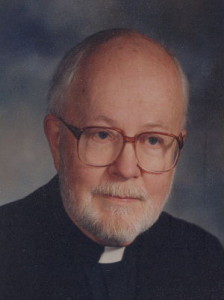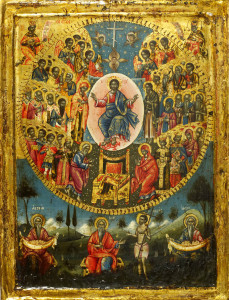As our brothers were preparing to come to Chicago to begin living the quasi-monastic life of the Community of Jerusalem, one brother discovered an article written by the late Fr. Aidan Kavanagh, OSB. Fr. Aidan was a monk of St. Meinrad’s Archabbey and a liturgist. His book On Liturgical Theology is a modern classic, a book to be read and savored again and again. The article appeared in Worship magazine, and, if memory serves, was his acceptance speech upon receiving an award from St. John’s School of Theology in Collegeville, named for Virgil Michel, OSB, one of the great figures of the early liturgical movement in the U.S. The write-ups on him that you can find on-line don’t quite capture Fr. Aidan’s genius, in my opinion. At some point I will review the book, but for now I want to point out what caught our founders’ attention in his article.

Fr. Aidan Kavanagh:
“Genesis says that we began in a swamp teeming with life, but that something went vastly wrong one evening at dinner. Apocalypse says that the difficulty was finally resolved into something called the Banquet of the Lamb. Hebrews tells us how the resolution was accomplished, not in an orchard set in pleasant countryside but in a butcher shop located in the city’s center. The World’s story from beginning to end pivots upon this resolution, a resolution the faint of heart, the fastidious, and the squeamish find hard to bear.”
He described being at a thanksgiving Mass celebrated by a newly ordained priest, one of his former students. At the fraction rite (during the singing of the Lamb of God), Fr. Aidan watched the new priest place a small piece of the Blessed Sacrament, under the form of bread, into the chalice. He noted that the priest probably could not give a good explanation of why he did that at that moment. But he did it anyway, out of obedience to canonical form. It is this emphasis on the sense of a ‘canon’ that struck our brothers so much.
In seminary in the 1970’s, formation was an unruly business. No one seemed to be quite sure what the bishops wanted in the wake of the liturgical reforms and the dense theology of the documents of the Second Vatican Council. So Mass and the Divine Office were invented anew virtually every day. The feeling was that men training to be priests should have experience in trying to invent relevant forms of worship that would speak to contemporary people. But the seminarians famously disagreed with one another on how this should be done, and they furthermore disagreed with their formators. Teachers of liturgy encouraged the seminarians, in some cases, simply to omit rituals that were opaque and apt to be misunderstood. Thus the idea that there might be merit in carrying out just such an action was like a bolt from the blue.
This set our young community on a course of gradually adopting a more ‘canonical’ approach to liturgy. I should clarify what I mean by canonical. I don’t mean a nervous or fussy rubricism or an idealization of one era of liturgy over another. As we have understood it, it is simply a receptivity to what the present discipline (kanon–measure or rule) of the Church is, according to documents having the authority of law, and a receptivity to the continual tradition out of which our present discipline grows. The point is not precisely to get liturgy correct (though that’s to be preferred, other things being equal). It is rather to allow the liturgy to form our sensibilities through ritual action and word, done together with all kind of people. It is to allow the liturgy to make us different kinds of persons, able to see things that we formerly could not. By this process, we began to discover that there were often very good reasons why, for example, priests should vest in alb and stole and even chasuble; why the sign of peace is not a time to leave the altar and shake hands with as many people as possible; why concelebrating priests should sit together in one place to the extent that it is feasible, and so on. These are not necessarily things that can be explained outside of the actual experience of doing them.
This happens to be the Church’s ancient pattern of mystagogy, the explanation of the mysteries of salvation. Catechumens in the early Church were first baptized, and then the bishop explained the significance of the ritual sacramental action, encouraging repeated reflection on the sacrament (sacramentum is the Latin word for ‘mystery’) as the means of understanding God’s action in the world. This is another way to demonstrate lex orandi lex credendi. First deposit the fragment of consecrated bread in the chalice, then reflect and live out of the reflection of this ritual action.
This does bring us up short at times, where a ritual action is called for, and we don’t remember why it’s there, nor does it become clear even after many repetitions. What this might be suggesting to us is that we have some ways to go before we have fully adjusted to a spiritual point of view, that we are still thinking too functionally, practically, and narrowly. We have been called out of darkness into the wonderful light of Christ’s Kingdom, and the old familiar world is passing away. But we at least are well acquainted with that old, dying world, and sometimes we prefer it.

“In a Christian assembly’s regular Sunday worship, a restored and recreated world must be so vigorously enfleshed in ‘civic’ form as to give the lie to any antithetical civitas.” –Fr. Kavanagh
The liturgy is a time to practice living in the New Order of creation, the Eighth Day that is now silently permeating and renewing all things for those who have the eyes to see it. Our first experience of this new creation at times may well be a sense of total unfamiliarity, a reminder that we still inhabit, by our dispositions and desires, the Land of Unlikeness. Rather than impatience with the liturgy or frustration at our slowness to understand, we should allow this restlessness to remind us that we will not rest until our hearts rest in the infinite God.
And the problem with reinventing the liturgy without reference to the canon is that we can end up placing all of our hope in our own resources. We can become Pelagians. When we take a receptive stance toward the liturgical canon,
“Along with the blood-bought right of Christian orthodoxia to celebrate creation root and branch, there goes an obligation to exorcize continually its human inmates’ lust to do their own thing.”–Fr. Kavanagh
God enters the picture and the Holy Spirit becomes an agent in our transformation. We allow ourselves to be taken up in the divine embrace, in a participation of the high priesthood of the True King, Jesus Christ.
Will we rejoice in this welcome?